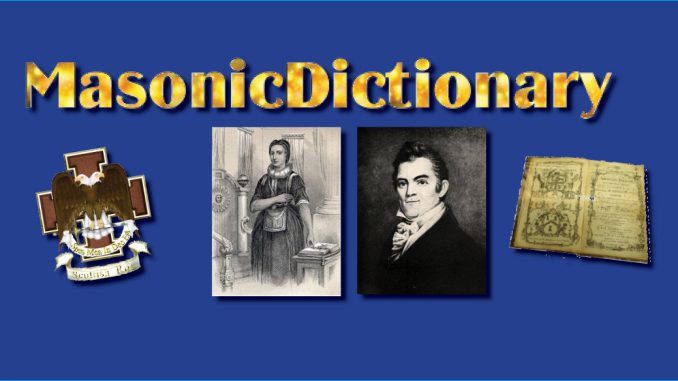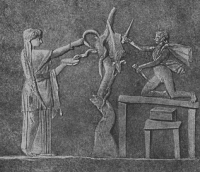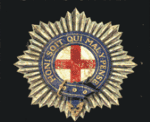
by Bro. John W. Wells, Iowa
IN presenting the Apron to a Brother, we say that it is more ancient than the Golden Fleece or the Roman Eagle, more honorable than the Star and Garter, or any other order that might be conferred, etc.
Are these claims true? We shall examine them severally.
 The Golden Fleece.
The Golden Fleece.
In Greek tradition, the fleece of the Ram Chrysomallus, the recovery of which was the object of the Argonautic expedition.
“The Golden Fleece” has given its name to a celebrated Order of Knighthood in Austria and Spain, founded by Philip III. Duke of Burgundy and the Netherlands, at Bruges, on the tenth of January, 1429, on the occasion of his marriage with Isabella, daughter of King John I. of Portugal.
This Order was instituted for the protection of the Roman Catholic Church, and the fleece was assumed for its emblem, from being a staple commodity of the low countries. The founder made himself Grand Master of the Order, a dignity appointed to descend to his successors; and the number of knights, at first limited to twenty-four, was subsequently increased.
Contests arose between Spain and Austria as to the possession of this Order of Knighthood, which were finally adjusted by introducing the Order into both countries. In Austria the Emperor may now create any number of Knights of the Golden Fleece from the nobility. If Protestants, the consent of the Pope is required. In Spain, Princes, Grandees, and personages of peculiar merit are alone eligible to membership in this Order.
The legend of the Golden Fleece, for which the Argonauts searched, is like the story of Masonry, a search for that which was lost. It is familiar to most readers of poetry and myths, and is interesting as being among the first known voyages of discovery.
The Roman Eagle
 The Eagle as adopted by the Romans upon their banners, signified magnanimity and fortitude, or as in the ancient Sacred Writings, swiftness and courage. The Romans were not the first to display the Eagle upon their banners, for the Persians, under Cyrus the Younger, had borne the Eagle upon their standards.
The Eagle as adopted by the Romans upon their banners, signified magnanimity and fortitude, or as in the ancient Sacred Writings, swiftness and courage. The Romans were not the first to display the Eagle upon their banners, for the Persians, under Cyrus the Younger, had borne the Eagle upon their standards.
In modern times France, Russia, Prussia, and the United States have adopted the Eagle as a National military symbol.
The Order of the Black Eagle, in Prussia, was instituted in 1701, on the occasion of the coronation of the King. The number of Knights was first limited to thirty, in addition to the princes of the Royal family; but now the number is unlimited. They must be at least thirty years of age, and must prove noble descent through both parents for at least four generations. Chapters of the Order of the Black Eagle are held twice a year. It is the highest Order in Prussia. No member is allowed to travel from Court more than twenty miles without permission or giving notice.
The Order of the Red Eagle, founded in 1734, was afterwards made a subordinate degree to the Order of the Black Eagle, and those received into the Black, must now pass through the Order of the Red Eagle.
These Orders are outgrowths of the original symbol of the Roman Eagle.
The Star and The Garter
 These are two Orders.
These are two Orders.
The Order of the Star originated in France, and was founded by John II. in 1350 in imitation of the recently instituted Order of the Garter in England. The name of the Order has allusion to the Star of Bethlehem, or the Star of the Magi. A star of some design, from five to sixteen points, forms a part of the symbolism in every Order of Knighthood. The Order of the Garter dates from about 1344. Its origin is not certain. Edward III. is said by some to have instituted it. Others say Richard I. at the siege of Acre, when he is said to have caused 26 Knights to wear thongs of blue leather around their legs.
Another account is, that the Countess of Salisbury happened at a ball to drop her garter, and the King picking it up, presented it to her. Some of the company smiled, whereupon the King exclaimed “Honi Soit Qui Mal y pense” (Evil to him who evil thinks.) Immediately after this circumstance this Order of the Garter was founded. It was founded in honor of the Holy Trinity–The Virgin Mary, St. Edward the Confessor and St. George. The last, who had become the tutelary saint of England, was considered its special patron. It is known as the Order of St. George, as well as of the Garter. Its members are also known as Knights of St. George.
The number of Knights was originally twenty-six, including the Sovereign, who is the Chief of the Order; but in 1786 an order was passed increasing the number to include all the princes of the Royal family, and illustrious foreigners on whom the Order might be conferred.
The Garter is a dark blue ribbon, edged with gold, bearing the motto, “Honi Soit qui Mal y pense” (Evil to him who evil thinks) in gold letters, mounted with a gold buckle, and worn on the left leg below the knee. The mantle is of blue velvet; on the left breast is a star. The hood is of crimson velvet lined with white The hat is of black velvet with a plume of white ostrich feathers, in the center of which is a tuft of black heron’s feathers, all fastened by a band of diamonds. The “George” is a figure of St. George encountering a dragon, and is worn on the collar, while a lesser “George” pendant to a dark blue ribbon, is worn over the left shoulder.
This Order is perhaps the best known of any except the Order of Knights Templar. In many respects The Garter and the Order of the Temple resemble each other.
In comparing all these orders, The Golden Fleece, The Roman Eagle, and the other European orders of the Eagle, The Star and the Garter, Freemasonry may well claim to be more ancient than any or all of them; for in some form, well nigh akin to its present form, Masonry has existed for many centuries.
-Source: The Builder – October 1915
